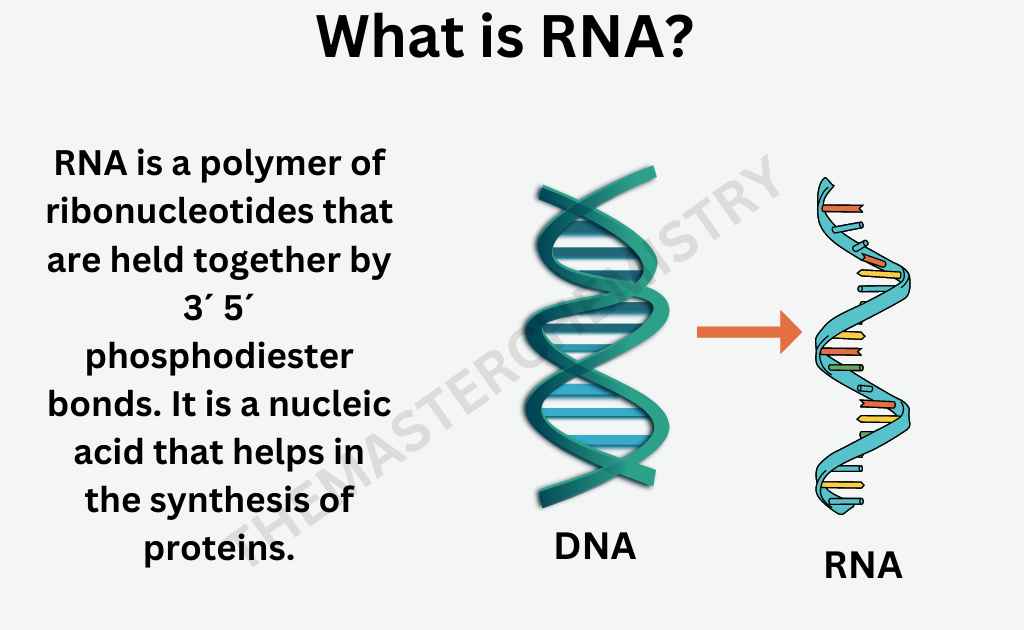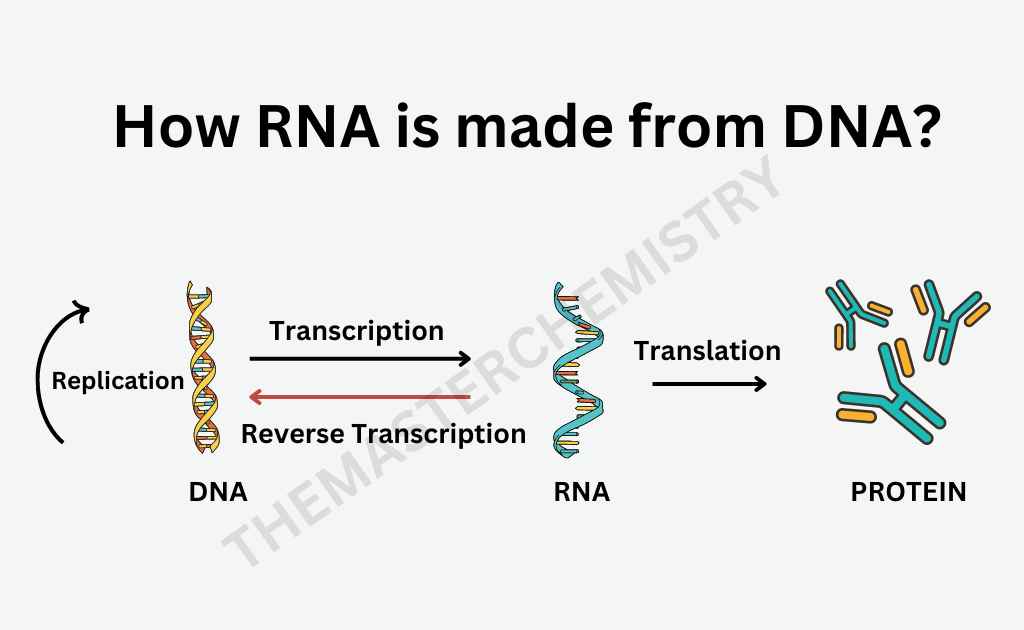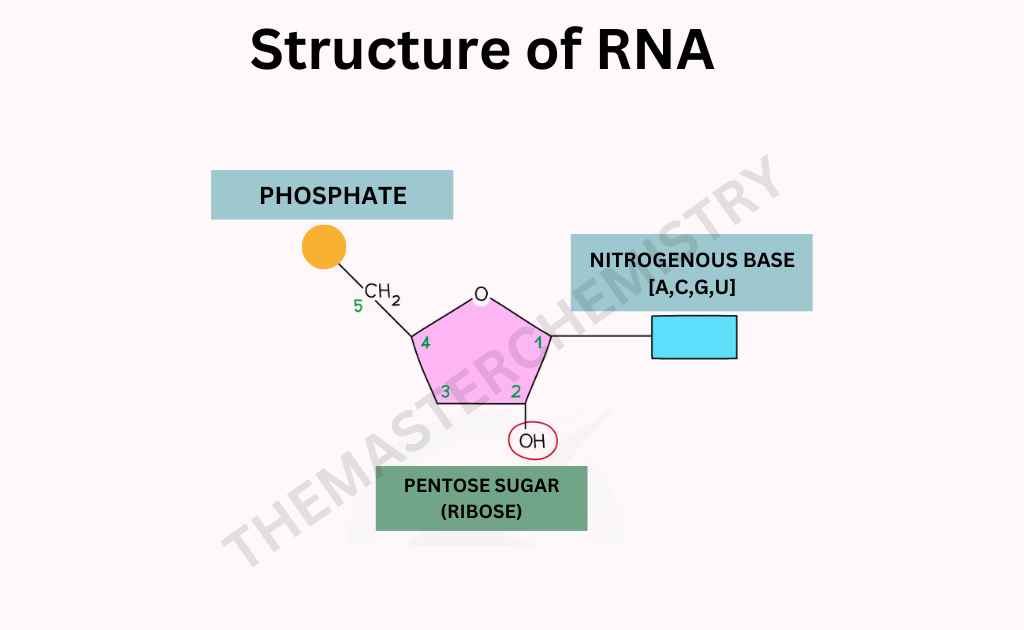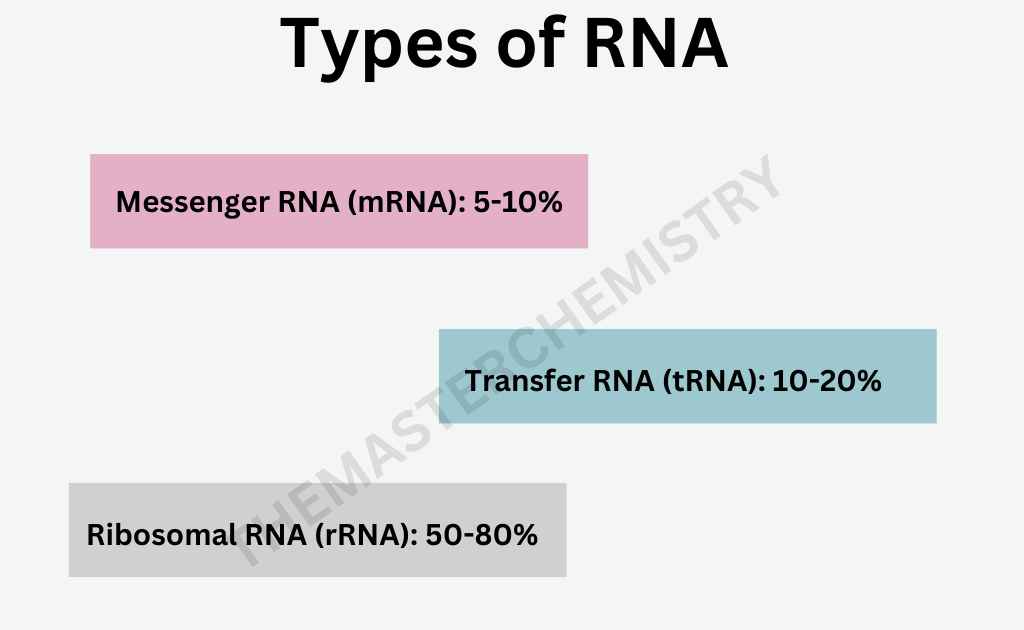LEARNING OBJECTIVES
In this article, author has explained the introduction, structure and functions of RNA. Author has also explained the different types of RNA.
RNA is a polymer of ribonucleotides that are held together by 3´ 5´ phosphodiester bonds. It is a nucleic acid that helps in the synthesis of proteins. RNA is involved in the transcription, decoding, and translation of genetic code to form proteins. It is also responsible for the production of new cells in the body.

RNA is synthesized from DNA. Unlike DNA, RNA is single-stranded. RNA is also considered as an enzyme as it assists many chemical reactions in the body.

Structure of RNA
Table of Contents
RNA is a single-stranded structure. Like DNA, RNA is also made of three components:
- Nitrogenous bases
- Pentose sugar
- Phosphate group

There are four types of nitrogenous bases present in the RNA; adenine, cytosine, guanine, and uracil. Thymine is absent in the RNA. Uracil is present in the place of thymine. Adenine is linked with uracil through two hydrogen bonds while cytosine links with guanine through three hydrogen bonds.
The sugar in RNA is ribose sugar. Ribose sugar attaches to the phosphate to form the backbone of nucleic acid.
The phosphate group consists of a phosphorus atom attached to the four oxygen atoms. The phosphate group acts as a bridge between two nucleotides. The nucleotides are attached to each other by phosphodiester bonds.

Types of RNA
There are three types of RNAs. The cellular composition of three types of RNAs is:
- Messenger RNA (mRNA): 5-10%
- Transfer RNA (tRNA): 10-20%
- Ribosomal RNA (rRNA): 50-80%

Besides these three, other types of RNAs are also present in the cell. They are heterogeneous nuclear RNA (hnRNA), small nuclear RNA (snRNA), and small cytoplasmic RNA (scRNA). RNA is synthesized from DNA. The main function of RNA is to make proteins. All the RNAs are different with respect to their function and structure.
Messenger RNA (mRNA)
mRNA is synthesized in the nucleus. After synthesis RNA is released into the cytoplasm to perform its functions. mRNA carries genetic code from the DNA. The coding sequence of the mRNA determines the sequence of the proteins. After being transcribed from the DNA, RNA exists as precursor mRNA. Certain modifications of precursor mRNA occur then it is processed into fully mature mRNA. This processing step removes (introns) the non-coding regions of mRNA. This is called “splicing of RNA”. There are about 23,000 mRNAs encoded in the human genome.
mRNA has a high molecular weight. The eukaryotic mRNA is more stable as compared to prokaryotic mRNA. In eukaryotes, mRNA is capped at the 5 ends, and at the 3 ends, polyadenylate tail is present. This modification protects the mRNA from hydrolysis by the nucleases. The cap is also involved in the recognition of mRNA for protein synthesis and provides stability to the structure of mRNA.
Transfer RNA (tRNA)
Transfer RNA consists of 71-80 nucleotides. the molecular weight of tRNA is about 25,000. Transfer RNA performs the function of transferring specific amino acids that correspond to the mRNA sequence into the growing polypeptide chain at the ribosome.
There are 20 species of tRNA. Each specie consists of 20 different types of amino acids. The structure of tRNA was first explained by Holley. tRNA consists of four arms:
1. The acceptor arm
The acceptor arm is capped with a sequence CCA. The amino acid is attached to the acceptor arm.
2. The anticodon arm
This arm has three specific nucleotide bases known as an anticodon. It recognizes the triplet codon of mRNA. The anticodon of tRNA and codon of mRNA are complementary to each other.
3. The D arm
The D arm consists of dihydrouridine.
4. The TΨC arm
This arm consists of a sequence of pseudouridine (represented by psi, Ψ) and C.
5. The variable arm
This arm is variable in tRNA. Based on the variability, tRNAs are classified into two categories:
Class l tRNAs: this consists of 3-5 base pairs.
Class ll tRNAs: This class consists of 20-30 base pairs long arm.
Base pairs in tRNA
The structure of tRNA is stabilized due to complementary base pairing in the arms. The base pairs in four arms of tRNA are:
The acceptor arm: 7 base pairs
The TΨC: 5 base pairs
The anticodon arm: 5 base pairs
The D arm: 4 base pairs
Ribosomal RNA (rRNA)
Ribosomal RNA is the catalytic part of ribosomes. In the cytoplasm, rRNA, and protein combine to form the nucleoprotein known as ribosomes. Ribosomes are factories of protein synthesis. The ribosome in eukaryotes is composed of two major units; 60S subunit and 40S subunit. The rRNA binds with ribosomes for the synthesis of proteins.
Functions of RNA
- The primary function of RNA is to facilitate the translation of DNA into proteins.
- Like DNA, RNA also carries genetic information in the cell.
- RNA directs the ribosomes to pick up the right amino acids which are required to build new proteins in the body.
- mRNA transfers genetic information from genes to ribosomes for the synthesis of proteins.
- The heterogeneous RNA serves as a precursor for the mRNA. It also serves as a precursor for many other RNAs.
- Transfer RNA (tRNA) transfers amino acids to the mRNA for the synthesis of proteins.
- Ribosomal RNA (rRNA) is a catalytic component of ribosomes. It provides a structural framework for the ribosomes.
- Small nuclear RNA (snRNA) involves in the processing of mRNA.
- Small nucleolar RNA plays role in the processing of rRNA molecules.
- Small cytoplasmic RNA selects protein for export.
- Transfer-messenger RNA adds short peptide tags to proteins to degrade the incorrectly synthesized proteins.